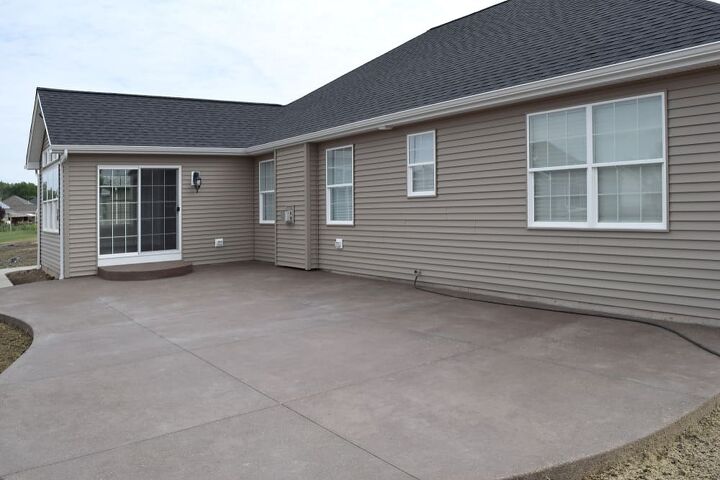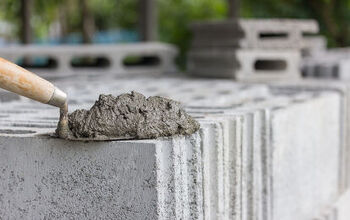Mortar Vs. Concrete: What Are The Major Differences?

Being familiar with numerous materials would be ideal if you want to build or make repairs in and around your home. At the very least, you should be familiar with basic materials such as mortar and concrete.
Not all homeowners may even be aware that concrete and mortar are different materials. As you’ll soon learn though, concrete and mortar are very distinct in terms of their qualities and how they are used. Knowing how to utilize both of them properly is absolutely crucial.
Both concrete and mortar consist of cement, sand, and water. However, concrete features something extra in its composition in the form of gravel or rock chips. Concrete is also often used to make slabs and foundations while mortar is typically utilized as a kind of binding agent.
Whether you’re looking to build an addition to your home or make repairs, knowing the materials you’re working with is important. Find out precisely how concrete and mortar are comparable by continuing with the rest of the article.
Do You Need Concrete, Brick, or Stone Pros?
Get free, zero-commitment quotes from pro contractors near you.

The Differences between Concrete and Mortar
Concrete and mortar aren’t completely dissimilar to one another. For instance, you’ll need cement, sand, and water to create both building materials. Concrete and mortar are also both easy to acquire as they are sold in ready-to-use bags.
That’s about where the similarities end, however. Upon comparing the two, you’ll find that they actually are quite different. Let’s discuss the many ways in which concrete and mortar are different from one another below.
Material Composition
As noted earlier, both concrete and mortar feature the same basic components, with those being cement, sand, and water. It’s the added components that make the real difference, however.
Typically, manufacturers add elements such as gravel and rock chips to concrete mixes. It doesn’t always have to be gravel or rock. However, there must be some kind of aggregate material that adds more body that is present in the mixture. Those aggregate materials are important additions because they strengthen the concrete. Once the concrete dries, the larger pieces in the mixture set and they create a strong structure.
Mortar relies on the same building blocks as concrete, but the aggregate materials are removed. In their place, manufacturers introduce a lime additive. The purpose of that lime additive is to make the mortar more durable and lengthen its period of effectiveness.
Consistency
The textures of concrete and mortar change significantly once they’re mixed. Mortar usually turns out to be a thicker mixture owing in large part to having a higher water to cement ratio. In contrast, concrete tends to be thinner because the water to cement ratio is lower.
The difference in consistency after they are mixed is not just a visual disparity. It also affects the performance of the materials themselves.
Strength Level
You will find a noticeable disparity in terms of how strong mortar and concrete are. Generally speaking, mortar is weaker than concrete and that makes sense given how they are often used.
Notably, though, the strength level of both concrete and mortar can also be influenced by different factors. The water to cement ratio usually plays a huge role in determining how strong a concrete mixture will be. The specific blending of materials in a mortar mixture will have a significant impact on how strong it ultimately becomes.
Durability
Concrete has an edge over mortar in terms of durability. The introduction of the lime additive does close the durability gap somewhat, but mortar still lags well behind concrete.
Uses
Homeowners need to be very careful when shopping for building materials. It’s especially important to be cautious when choosing between concrete and mortar because the two have different applications.
Starting with concrete, you should look at it as a kind of foundational material. Concrete is used to create slabs, patios, and foundations. You’ll also see it utilized to create load-bearing elements such as beams and columns. If you need a material capable of holding plenty of weight for a long time, you cannot go wrong with concrete. The strength it possesses will not let you down.
Mortar is not used in those aforementioned applications. That would simply be unwise because mortar lacks the strength needed to support a significant amount of weight. It could crumble under the weight of the load you’re asking it to bear even after it has dried.
To get the most out of mortar, you must deploy it as a kind of adhesive. It works especially well when used to bind bricks and blocks during construction. Inside the home, you may also find mortar used to stick tiles to the bathroom walls.
An interesting thing to note here is that concrete also does possess some adhesive qualities. It simply isn’t on the same level as what mortar is capable of in that regard. Make use of concrete’s adhesive qualities for decorative pieces, but don’t rely on it to hold important components together.
Reinforcement
Mortar cannot be reinforced. That doesn’t matter anyway since mortar usually isn’t called upon to support a lot of weight.
On the other hand, you’ll often find concrete slabs that are reinforced. Construction workers may use rebar or another kind of steel to increase the amount of weight the concrete slab holds.
What are the Different Types of Concrete?
There’s more than one type of concrete available on the market. You may even find that there’s a surprising amount of variety to parse through. It’s important to carefully consider your options in order to find the best fit for your intended application.
Regular Concrete
This is the garden-variety type of concrete and the one that’s usually used for home repair projects. It doesn’t feature any unique qualities but remains dependable as a building material.
Lightweight Concrete
Compared to the regular variant, lightweight concrete is easier to mix and control. It doesn’t quite feature the strength of regular concrete though. That’s why it’s often limited to applications where it doesn’t have to support an excessive amount of weight.
High-Density Concrete
High-density concrete is used in places where radiation is a concern. The thickness of the material prevents the easy flow of radiation from one room to the next.
Stamped Concrete
Stamped concrete resembles the regular kind in terms of its capabilities. You shouldn’t use this option if you need something sturdier. Instead, consider using stamped concrete if you want something that looks more like natural stone. That characteristic makes it better to use inside certain locations.
Self-Consolidating Concrete
Are you looking for an easier kind of concrete to work with? Self-consolidating concrete may be what you need. It requires less preparation compared to other options and it makes sense if you need to apply repairs quickly.
Reinforced Concrete
We already touched on reinforced concrete earlier and how steel is often used as the strengthening component. You should know that other materials can also be used to reinforce the concrete. Glass fibers are among the other materials that can be added to enhance the strength of this building material.
What Are the Different Types of Mortars?
Similar to concrete, you can also find different types of mortar on the market. They possess different qualities so make sure you choose the right one for your intended application.
Type K
This is a fairly uncommon type of mortar. It’s not quite as commonly used as the other options because it doesn’t offer much in terms of compressive strength. When Type K mortar is used, it’s often just limited to masonry.
Type M
In stark contrast to Type K mortar, Type M mortar boasts a lot of compressive strength. Type M mortar is not a good adhesive however and that’s why it’s best used indoors.
Type N
Type N mortar is the multi-purpose option. If you are lacking a specific type of mortar to use for a particular application, Type N is a good substitute.
Type O
Choose Type O mortar if you want something that can be easily applied. The downside to this mortar type is that it lacks compressive strength and that limits how useful it can be.
Type S
Type S mortars can come close to what Type M mortars offer when it comes to compressive strength. On top of that, Type S mortars offer a decent amount of adhesive strength. They are often considered to be more versatile than the Type M mortars.
Do You Need Concrete, Brick, or Stone Pros?
Get free, zero-commitment quotes from pro contractors near you.

Related Questions
Can You Turn Mortar into Concrete?
Given their somewhat similar compositions, one may assume that you can turn mortar into concrete. You can probably create a decent approximation of genuine concrete by adding aggregate materials to mortar, but it’s not the same.The presence of lime inside the mortar will prevent it from featuring the same kind of strength that concrete does. If you need concrete, you’ll be better off buying some additional bags instead of trying to transform mortar.
Are Mortar and Grout the Same Thing?
Although mortar and grout appear very similar, they are not the same type of material. Mortar is mainly used as an adhesive while grout’s main job is to fill in gaps. Use grout in spots where you need to fill a space, but want to avoid sticking items together.

We are a team of passionate homeowners, home improvement pros, and DIY enthusiasts who enjoy sharing home improvement, housekeeping, decorating, and more with other homeowners! Whether you're looking for a step-by-step guide on fixing an appliance or the cost of installing a fence, we've here to help.
More by Upgraded Home Team



























